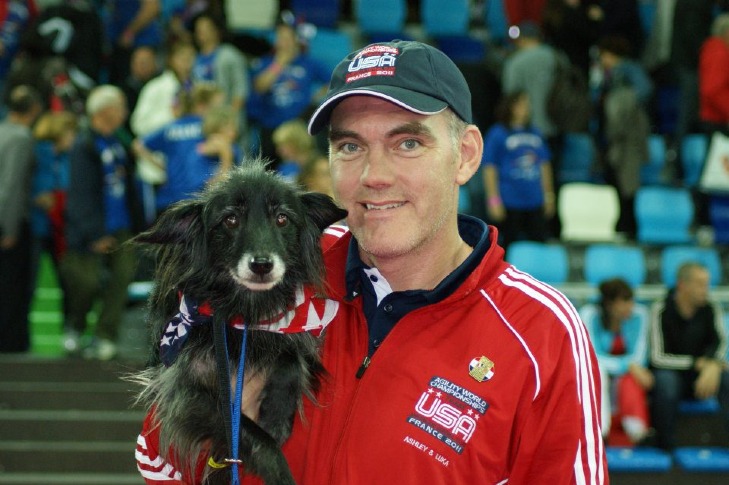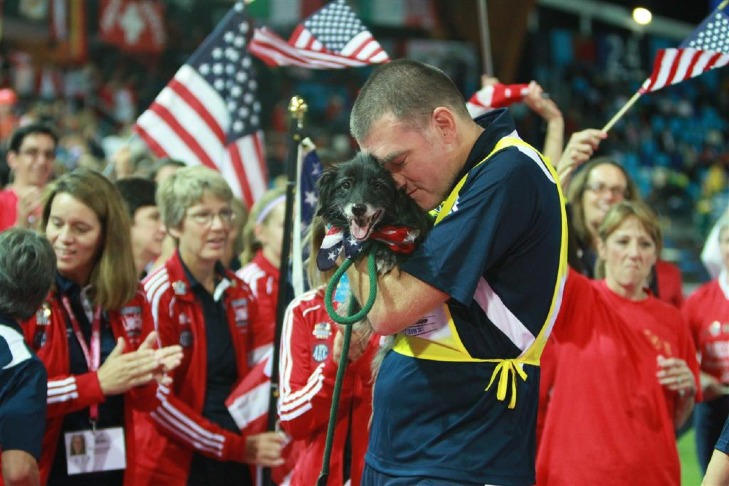Printed with permission from Purina Pro Plan
AKC Agility League course designer Ashley Deacon loves to inspire people to build positive connections with their dogs. He believes one of the best ways to do that is through the sport of dog agility.
“Agility is a great way to have a good relationship with your dog. It encourages you to devote some special one-on-one time to your dog each and every day,” says Deacon, who has designed all the International Sweepstakes Class (ISC) courses of the Ph.D. Division since the AKC Agility League began in 2022.
Deacon has experienced firsthand the bond that can develop between a handler and agility dog. His introduction to agility transformed him into an aficionado of the sport and his dog into a superstar at elite AKC agility competitions and on the international stage.
“I got my first dog, ‘Luka’ (3XNAC MACH3 Luka De La Brise MXG MJC XF), a Pyrenean Shepherd, in 2002 with no intention of doing dog agility,” he says. “She was my trail-running companion. However, things changed when we started learning about agility in 2003.”
In 2009, Deacon and Luka represented the AKC as members of the USA Medium dog team that won a silver medal at the Federation Cynologique International (FCI) Agility World Championship in Dornbirn, Austria. In 2011, they won gold in the Medium Individual competition at the FCI Agility World Championship in Liévin, France.
Applying elements akin to FCI competitions, Deacon stamps his ISC courses with a flowing and fun design. “I like to keep the dogs and the handlers moving,” he says. “The courses should be motivating for the team while presenting challenges at a speed to keep them on their toes.”
Modeled after European-style agility, ISC courses are longer, faster and more technical. While the Regulation Ph.D. courses are limited to 100-by-70 feet and Extended Ph.D. courses are 100-by-100 feet, Deacon tries to make the most of the available area to create ISC-like challenges. Not only must dogs run fast to do well, they also must be independent and forward-focused to make quick decisions.
A native of Bolton, England, Deacon keeps up with international course designs from a competitor’s perspective. He has been designing courses for about 10 years for the international-level and Masters-level agility classes he teaches at Golden Gate Dog Sports in San Francisco, a 7,500-square-foot training facility that he co-owns.
“European agility has evolved quite differently from how agility has evolved in this country,” he says. “The rings are longer and narrower, around 140-by-90 feet, which has influenced the style of international courses. They have longer, faster lines, which exacerbates course challenges because the dog is faster and may be ahead of the handler.”
The popularity of ISC courses led to the AKC adding the Ph.D. Division to its AKC Agility League after the pilot season. The League offers four divisions according to skill levels in which teams of three to eight dogs train at their home facility and record their scores on six courses over 12 weeks. The AKC calculates team scores based on the average of all the dogs on the team. Three seasons are held each year.
“We were receiving so much feedback from competitors around the country that they wanted more opportunities to practice on ISC-style courses,” says Penny Leigh, Director of the AKC Agility League. “We are lucky to have Ashley as the designer for our Ph.D. Division. He truly understands international competition and course design. Our competitors tell us how much they love his courses”
An important part, Deacon says, is not to overwhelm competitors.
“I try to simulate the style of challenges you see on an international course by keeping the speed, tempo and flow. I want a balance of the skills that handlers can accomplish realistically and keep the courses fun as well,” he says. “The idea is for handlers to be able to practice the skills and understand how they can communicate with their dogs to be successful on ISC courses.”
Handlers and dogs with a wide range of skills enroll in the Ph.D. Division.
“If you have a dog and are competing at the high levels of AKC agility, you can give it a shot,” Deacon says. “It depends on your training history, knowledge of the sport and the skills you have trained on your dog. People have been using the Ph.D. level courses to train and improve their skills.”
A challenging element often seen on ISC courses is back side jumps.
“To succeed on back side jumps, if your dog is driving ahead of you and you cannot be there, you have to have a strong verbal command telling the dog to go around the jump and take it from the far side,” he says. “I usually place back side jumps on a natural line for the dog, so the dog does not have to divert from its natural path, but it must understand its job.”
A tunnel under the dog walk is another popular ISC course element.
“The handler has to send the dog through the tunnel to the next obstacle independently, as the dog walk impedes the handler’s path,” Deacon explains. “The dog transitions from something happening on one side of the dog walk to something happening on the other side. The dog needs to drive through the tunnel and be looking for the next thing to do, not looking back at the handler for what to do next.”
On ISC courses, obstacles are typically spaced 25 feet apart. This encourages dogs to stretch out and move fast, Deacon says, noting that other obstacles can be close to the dog’s path.
“Since the dog is moving fast, the handler must work the dog at a distance to stay ahead on the course. Sometimes there are obstacles in the handler’s path and the handler must decide whether to stay close to the dog’s path or ‘layer’ the obstacle to take a shortcut to get ahead of the dog,” Deacon says. “Course designers often build in specific ‘layering’ challenges that give handlers two path options.
“Discrimination challenges require the dog to choose between two options that are close to its path. The dog may need to bypass an obstacle on the way to the correct one,” he says. “As with the tunnel under the dog walk, the dog must have forward focus and choose the correct obstacle to perform with the handler at a distance.”
Deacon’s ISC course designs are a culmination of 22 years in the sport as a competitor, trainer and agility teacher. Developing a complete course design can take a few hours and involves fine-tuning a first draft.
“I’ll often sketch a course and then put it away,” he says. “I’ll come back to it with fresh eyes the next day and sometimes realize something wasn’t quite how I wanted it to be. At this point, I often rearrange things to make the whole course work. The final product needs to be fun and most importantly safe for dogs and their handlers.”
Getting more people interested in ISC courses is one of his goals.
“If I provide an accessible version of what you might see at an FCI Agility World Championship, people will see they have a chance of success by developing and rehearing their skills and teamwork,” Deacon says.
Recalling his start in agility in 2003 with his Pyrenean Shepherd, Deacon says, “Luka is the dog I did everything wrong with the first time I tried.”
Well, not everything. In addition to being a four-time FCI Agility World Championship team competitor on the AKC World Team, Luka was a three-time AKC National Agility Championship winner in 2007, 2011 and 2012. She also was a two-time AKC Agility Invitational winner.
Agility is Deacon’s passion and hobby. Through his ISC course designs, he aims to inspire others to experience the thrill of building great relationships with their dogs and succeeding in the sport.



